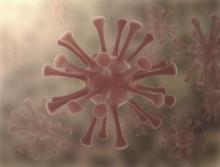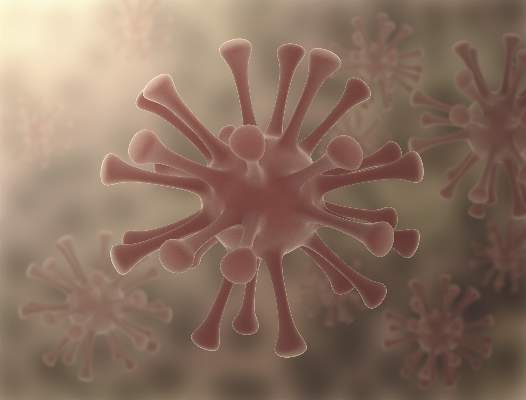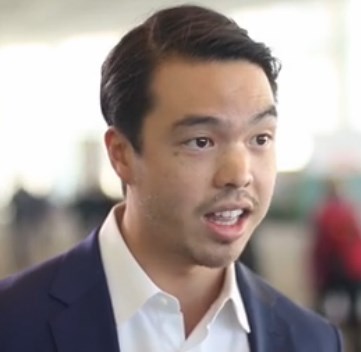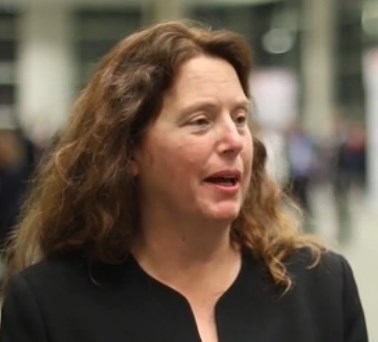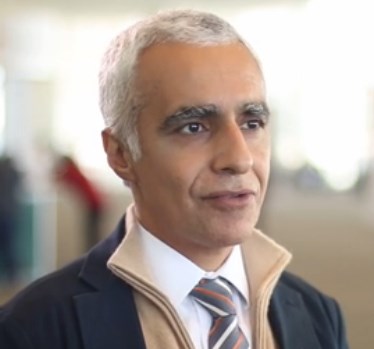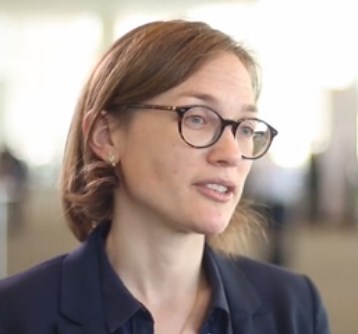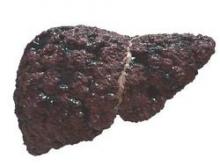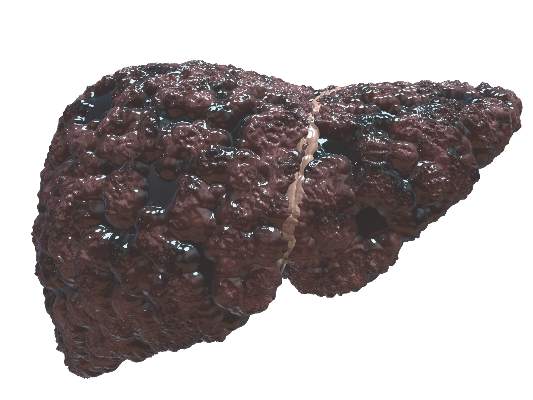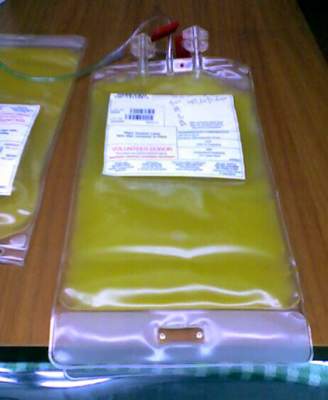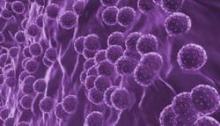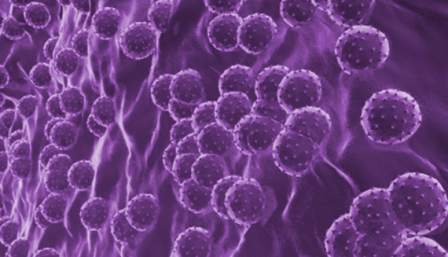User login
American Association for the Study of Liver Disease (AASLD): The Liver Meeting
High SVR achieved in decompensated HCV patients with 12-week therapy
SAN FRANCISCO – In patients infected with hepatitis C virus (HCV) who have decompensated liver disease, a 12-week combination drug regimen with velpatasvir and sofosbuvir (VEL/SOF) with or without ribavirin (VEL/SOF/R) achieved an overall sustained virologic response (SVR) rate of 94%, according to a late-breaker trial presented at the annual meeting of the American Association for the Study of Liver Diseases.
The phase III trial, called ASTRAL-4, randomized patients with HCV genotypes 1, 2, 3, 4, and 6 to one of three regimens. The simplest regimen, which required a single daily pill, achieved 100% SVR rates in genotypes 2 and 4, according to Dr. Michael R. Charlton of Intermountain Medical Center, Salt Lake City, Utah.
In this trial, 267 patients with HCV and decompensated liver disease were randomized to 12 weeks of 400 mg sofosbuvir and 100 mg velpatasvir in a fixed-dose single-pill combination, 12 weeks of SOF/VEL plus weight-based ribavirin (VEL/SOF/R), or 24 weeks of VEL/SOF. The majority (55%) were treatment experienced. Patients with hepatocellular carcinoma or prior liver transplant were excluded. Most (78%) had genotype 1 HCV. Only one patient had genotype 6.
On VEL/SOF alone for 12 weeks, the SVR rates ranged from 100% in patients with genotypes 2 or 4 HCV to 88% in genotype 1 and 50% in genotype 3. With the addition of ribavirin, the 12-week SVR rates climbed to 96% in the genotype1 group and 85% in genotype 3 group. After 24 weeks of VEL/SOF, the single genotype 6 patient in this trial achieved SVR.
SVR rates in those receiving VEL/SOF for 24 weeks were not much better than those achieved by the 12-week regimen. While SVR on the extended regimen was 100% in those with genotype 4 (as it was after 12 weeks), it remained 50% in genotype 3, which was achieved after 12 weeks. The SVR rate after 24 weeks VEL/SOF was 75% in genotype 2 patients and 92% in genotype 1 patients.
All regimens were well tolerated. Although 18% of patients experienced serious adverse events, all but one was considered to be unrelated to therapy. Most adverse events overall were consistent with the underlying liver disease or with the known side effects of ribavirin.
“Among patients who achieved SVR, 47% had improvements in Child-Pugh score and 57% had improvements in MELD scores 12 weeks after treatment, largely driven by increases in albumin and decreases in bilirubin,” Dr. Charlton said.
Emphasizing that the current treatment options for HCV with decompensated liver disease are “limited,” Dr. Charlton indicated that the SVR rates achieved with velpatasvir, a pangenotypic HCV NS5A inhibitor, in a fixed-dose pill with sofosbuvir are encouraging. Although the addition of ribavirin may be required for optimal SVR in some genotypes, several HCV subgroups appear to be adequately treated with a single once-daily pill taken over 12 weeks.
Gilead Sciences petitioned the Food and Drug Administration in October for approval of a fixed-dose combination of sofosbuvir/velpatasvir, according to a statement from the company.
Dr. Charlton reported financial relationships with Abbvie, Gilead, Janssen, Merck, and Novartis.
SAN FRANCISCO – In patients infected with hepatitis C virus (HCV) who have decompensated liver disease, a 12-week combination drug regimen with velpatasvir and sofosbuvir (VEL/SOF) with or without ribavirin (VEL/SOF/R) achieved an overall sustained virologic response (SVR) rate of 94%, according to a late-breaker trial presented at the annual meeting of the American Association for the Study of Liver Diseases.
The phase III trial, called ASTRAL-4, randomized patients with HCV genotypes 1, 2, 3, 4, and 6 to one of three regimens. The simplest regimen, which required a single daily pill, achieved 100% SVR rates in genotypes 2 and 4, according to Dr. Michael R. Charlton of Intermountain Medical Center, Salt Lake City, Utah.
In this trial, 267 patients with HCV and decompensated liver disease were randomized to 12 weeks of 400 mg sofosbuvir and 100 mg velpatasvir in a fixed-dose single-pill combination, 12 weeks of SOF/VEL plus weight-based ribavirin (VEL/SOF/R), or 24 weeks of VEL/SOF. The majority (55%) were treatment experienced. Patients with hepatocellular carcinoma or prior liver transplant were excluded. Most (78%) had genotype 1 HCV. Only one patient had genotype 6.
On VEL/SOF alone for 12 weeks, the SVR rates ranged from 100% in patients with genotypes 2 or 4 HCV to 88% in genotype 1 and 50% in genotype 3. With the addition of ribavirin, the 12-week SVR rates climbed to 96% in the genotype1 group and 85% in genotype 3 group. After 24 weeks of VEL/SOF, the single genotype 6 patient in this trial achieved SVR.
SVR rates in those receiving VEL/SOF for 24 weeks were not much better than those achieved by the 12-week regimen. While SVR on the extended regimen was 100% in those with genotype 4 (as it was after 12 weeks), it remained 50% in genotype 3, which was achieved after 12 weeks. The SVR rate after 24 weeks VEL/SOF was 75% in genotype 2 patients and 92% in genotype 1 patients.
All regimens were well tolerated. Although 18% of patients experienced serious adverse events, all but one was considered to be unrelated to therapy. Most adverse events overall were consistent with the underlying liver disease or with the known side effects of ribavirin.
“Among patients who achieved SVR, 47% had improvements in Child-Pugh score and 57% had improvements in MELD scores 12 weeks after treatment, largely driven by increases in albumin and decreases in bilirubin,” Dr. Charlton said.
Emphasizing that the current treatment options for HCV with decompensated liver disease are “limited,” Dr. Charlton indicated that the SVR rates achieved with velpatasvir, a pangenotypic HCV NS5A inhibitor, in a fixed-dose pill with sofosbuvir are encouraging. Although the addition of ribavirin may be required for optimal SVR in some genotypes, several HCV subgroups appear to be adequately treated with a single once-daily pill taken over 12 weeks.
Gilead Sciences petitioned the Food and Drug Administration in October for approval of a fixed-dose combination of sofosbuvir/velpatasvir, according to a statement from the company.
Dr. Charlton reported financial relationships with Abbvie, Gilead, Janssen, Merck, and Novartis.
SAN FRANCISCO – In patients infected with hepatitis C virus (HCV) who have decompensated liver disease, a 12-week combination drug regimen with velpatasvir and sofosbuvir (VEL/SOF) with or without ribavirin (VEL/SOF/R) achieved an overall sustained virologic response (SVR) rate of 94%, according to a late-breaker trial presented at the annual meeting of the American Association for the Study of Liver Diseases.
The phase III trial, called ASTRAL-4, randomized patients with HCV genotypes 1, 2, 3, 4, and 6 to one of three regimens. The simplest regimen, which required a single daily pill, achieved 100% SVR rates in genotypes 2 and 4, according to Dr. Michael R. Charlton of Intermountain Medical Center, Salt Lake City, Utah.
In this trial, 267 patients with HCV and decompensated liver disease were randomized to 12 weeks of 400 mg sofosbuvir and 100 mg velpatasvir in a fixed-dose single-pill combination, 12 weeks of SOF/VEL plus weight-based ribavirin (VEL/SOF/R), or 24 weeks of VEL/SOF. The majority (55%) were treatment experienced. Patients with hepatocellular carcinoma or prior liver transplant were excluded. Most (78%) had genotype 1 HCV. Only one patient had genotype 6.
On VEL/SOF alone for 12 weeks, the SVR rates ranged from 100% in patients with genotypes 2 or 4 HCV to 88% in genotype 1 and 50% in genotype 3. With the addition of ribavirin, the 12-week SVR rates climbed to 96% in the genotype1 group and 85% in genotype 3 group. After 24 weeks of VEL/SOF, the single genotype 6 patient in this trial achieved SVR.
SVR rates in those receiving VEL/SOF for 24 weeks were not much better than those achieved by the 12-week regimen. While SVR on the extended regimen was 100% in those with genotype 4 (as it was after 12 weeks), it remained 50% in genotype 3, which was achieved after 12 weeks. The SVR rate after 24 weeks VEL/SOF was 75% in genotype 2 patients and 92% in genotype 1 patients.
All regimens were well tolerated. Although 18% of patients experienced serious adverse events, all but one was considered to be unrelated to therapy. Most adverse events overall were consistent with the underlying liver disease or with the known side effects of ribavirin.
“Among patients who achieved SVR, 47% had improvements in Child-Pugh score and 57% had improvements in MELD scores 12 weeks after treatment, largely driven by increases in albumin and decreases in bilirubin,” Dr. Charlton said.
Emphasizing that the current treatment options for HCV with decompensated liver disease are “limited,” Dr. Charlton indicated that the SVR rates achieved with velpatasvir, a pangenotypic HCV NS5A inhibitor, in a fixed-dose pill with sofosbuvir are encouraging. Although the addition of ribavirin may be required for optimal SVR in some genotypes, several HCV subgroups appear to be adequately treated with a single once-daily pill taken over 12 weeks.
Gilead Sciences petitioned the Food and Drug Administration in October for approval of a fixed-dose combination of sofosbuvir/velpatasvir, according to a statement from the company.
Dr. Charlton reported financial relationships with Abbvie, Gilead, Janssen, Merck, and Novartis.
AT THE LIVER MEETING 2015
Key clinical point: High sustained viral response rates were achieved across hepatitis C virus genotypes with a two-drug fixed-dose combination that included a NS5A inhibitor.
Major finding: The overall SVR rate was 94% after 12 weeks of a fixed-dose combination of velpatasvir and sofosbuvir with ribavirin.
Data source: Multicenter, randomized, phase III study.
Disclosures: Dr. Charlton reported financial relationships with Abbvie, Gilead, Janssen, Merck, and Novartis.
New direct-acting antivirals for HCV perform well in real world
SAN FRANCISCO – The very high sustained virologic response (SVR) rates achieved with direct-acting antiretroviral agents in clinical trials are being replicated in the real-world setting, according to data from 1,225 patients presented in a late-breaker study at the annual meeting of the American Association for the Study of Liver Diseases.
The rates of SVR, treatment failure, and discontinuation of treatment among genotype 1 HCV patients treated with such direct-acting antivirals such as ledipasvir (LDV), sofosbuvir (SOF), and ombitasvir appear to be at least as good outside of clinical studies as those reported in the phase III trials, reported Dr. Nezam H. Afdhal of Beth Israel Deaconess Medical Center, Boston.
“Overall, SVR in real-world [genotype 1] patients was 94% across regimens and patient characteristics,” Dr. Afdhal reported.
In this study, the goal was to evaluate patients with genotype 1 HCV who failed 12-weeks of a multidrug regimen containing a direct-acting antiretroviral agent. The focus was on three regimens: ledipasvir/sofosbuvir (LDV/SOF); ombitasvir/paritaprevir/ritonavir + dasabuvir (VKP); and simeprevir/sofosbuvir (SMV/SOF). All three were evaluated with or without ribavirin. The data were collected from the Trio Health Innervation Platform, a cloud-based disease management program.
Over a nearly 18-month period from January 2014 to March 2015, 1,225 patients were treated with one of the regimens. SVR 12 weeks after completion of treatment was 94% for LDV/SOF, 97% for LDV/SOF with ribavirin, 91% for VKP with or without ribavirin, and 78% for SMV/SOF with or without ribavirin.
In total, 35 patients did not achieve SVR. Of these, six discontinued therapy before completing the regimen. The 29 who completed therapy were classified as virologic failures and were compared to those who did achieve SVR to determine factors associated with failure. Failure was not associated with being treated in a community practice relative to an academic center and there was no association between failure and age, race, viral load at baseline, presence of HIV co-infection, or prior liver transplant.
However, there were significant associations for treatment failure with male gender (P = .011), presence of cirrhosis (P less than .001), platelet count less than 100,000/mL (P less than .001) and prior treatment failure (P = .016).
Discontinuation rates for the new direct-acting antivirals are “not a major issue” in real world clinical practice, Dr. Afdhal said, adding that the findings support rates of efficacy comparable to those observed in phase III trials. The data indicated that patients with cirrhosis, thrombocytopenia, and prior treatment failure represent “the most difficult to treat” who may require intensified therapy, but the “remarkable” efficacy of these newer agents previously reported in controlled trials can be anticipated in routine patient care.
SAN FRANCISCO – The very high sustained virologic response (SVR) rates achieved with direct-acting antiretroviral agents in clinical trials are being replicated in the real-world setting, according to data from 1,225 patients presented in a late-breaker study at the annual meeting of the American Association for the Study of Liver Diseases.
The rates of SVR, treatment failure, and discontinuation of treatment among genotype 1 HCV patients treated with such direct-acting antivirals such as ledipasvir (LDV), sofosbuvir (SOF), and ombitasvir appear to be at least as good outside of clinical studies as those reported in the phase III trials, reported Dr. Nezam H. Afdhal of Beth Israel Deaconess Medical Center, Boston.
“Overall, SVR in real-world [genotype 1] patients was 94% across regimens and patient characteristics,” Dr. Afdhal reported.
In this study, the goal was to evaluate patients with genotype 1 HCV who failed 12-weeks of a multidrug regimen containing a direct-acting antiretroviral agent. The focus was on three regimens: ledipasvir/sofosbuvir (LDV/SOF); ombitasvir/paritaprevir/ritonavir + dasabuvir (VKP); and simeprevir/sofosbuvir (SMV/SOF). All three were evaluated with or without ribavirin. The data were collected from the Trio Health Innervation Platform, a cloud-based disease management program.
Over a nearly 18-month period from January 2014 to March 2015, 1,225 patients were treated with one of the regimens. SVR 12 weeks after completion of treatment was 94% for LDV/SOF, 97% for LDV/SOF with ribavirin, 91% for VKP with or without ribavirin, and 78% for SMV/SOF with or without ribavirin.
In total, 35 patients did not achieve SVR. Of these, six discontinued therapy before completing the regimen. The 29 who completed therapy were classified as virologic failures and were compared to those who did achieve SVR to determine factors associated with failure. Failure was not associated with being treated in a community practice relative to an academic center and there was no association between failure and age, race, viral load at baseline, presence of HIV co-infection, or prior liver transplant.
However, there were significant associations for treatment failure with male gender (P = .011), presence of cirrhosis (P less than .001), platelet count less than 100,000/mL (P less than .001) and prior treatment failure (P = .016).
Discontinuation rates for the new direct-acting antivirals are “not a major issue” in real world clinical practice, Dr. Afdhal said, adding that the findings support rates of efficacy comparable to those observed in phase III trials. The data indicated that patients with cirrhosis, thrombocytopenia, and prior treatment failure represent “the most difficult to treat” who may require intensified therapy, but the “remarkable” efficacy of these newer agents previously reported in controlled trials can be anticipated in routine patient care.
SAN FRANCISCO – The very high sustained virologic response (SVR) rates achieved with direct-acting antiretroviral agents in clinical trials are being replicated in the real-world setting, according to data from 1,225 patients presented in a late-breaker study at the annual meeting of the American Association for the Study of Liver Diseases.
The rates of SVR, treatment failure, and discontinuation of treatment among genotype 1 HCV patients treated with such direct-acting antivirals such as ledipasvir (LDV), sofosbuvir (SOF), and ombitasvir appear to be at least as good outside of clinical studies as those reported in the phase III trials, reported Dr. Nezam H. Afdhal of Beth Israel Deaconess Medical Center, Boston.
“Overall, SVR in real-world [genotype 1] patients was 94% across regimens and patient characteristics,” Dr. Afdhal reported.
In this study, the goal was to evaluate patients with genotype 1 HCV who failed 12-weeks of a multidrug regimen containing a direct-acting antiretroviral agent. The focus was on three regimens: ledipasvir/sofosbuvir (LDV/SOF); ombitasvir/paritaprevir/ritonavir + dasabuvir (VKP); and simeprevir/sofosbuvir (SMV/SOF). All three were evaluated with or without ribavirin. The data were collected from the Trio Health Innervation Platform, a cloud-based disease management program.
Over a nearly 18-month period from January 2014 to March 2015, 1,225 patients were treated with one of the regimens. SVR 12 weeks after completion of treatment was 94% for LDV/SOF, 97% for LDV/SOF with ribavirin, 91% for VKP with or without ribavirin, and 78% for SMV/SOF with or without ribavirin.
In total, 35 patients did not achieve SVR. Of these, six discontinued therapy before completing the regimen. The 29 who completed therapy were classified as virologic failures and were compared to those who did achieve SVR to determine factors associated with failure. Failure was not associated with being treated in a community practice relative to an academic center and there was no association between failure and age, race, viral load at baseline, presence of HIV co-infection, or prior liver transplant.
However, there were significant associations for treatment failure with male gender (P = .011), presence of cirrhosis (P less than .001), platelet count less than 100,000/mL (P less than .001) and prior treatment failure (P = .016).
Discontinuation rates for the new direct-acting antivirals are “not a major issue” in real world clinical practice, Dr. Afdhal said, adding that the findings support rates of efficacy comparable to those observed in phase III trials. The data indicated that patients with cirrhosis, thrombocytopenia, and prior treatment failure represent “the most difficult to treat” who may require intensified therapy, but the “remarkable” efficacy of these newer agents previously reported in controlled trials can be anticipated in routine patient care.
AT THE LIVER MEETING 2015
Key clinical point: Treatment failure on the new direct-acting antiviral therapies for hepatitis C virus (HCV) is uncommon in real-world practice.
Major finding: Three major factors predict treatment failure: cirrhosis, thrombocytopenia, and prior treatment failure.
Data source: Retrospective analysis of 1,225 patients with genotype 1 HCV.
Disclosures: Dr. Afdhal reported a financial relationship with Trio Health Care.
VIDEO: Survival benefits, relapse risks in liver transplant for alcoholic hepatitis
SAN FRANCISCO – Are policies requiring 6 months of abstinence before liver transplantation in severe alcoholic hepatitis justified, given the potential survival advantage that earlier transplantation offers?
Alcoholic hepatitis has an “exceptionally high mortality rate,” noted Dr. Brian Lee of Johns Hopkins University, Baltimore. But a policy requiring 6 months of abstinence before liver transplantation in patients with severe alcoholic hepatitis “is possibly even causing a precondition that’s death for these patients.”
In an interview at the annual meeting of the American Association for the Study of Liver Diseases, Dr. Lee discussed a study in which early liver transplantation in 40 patients with severe alcoholic hepatitis achieved a 100% survival rate at 1 year, with a 22% alcohol relapse rate.
The video associated with this article is no longer available on this site. Please view all of our videos on the MDedge YouTube channel
SAN FRANCISCO – Are policies requiring 6 months of abstinence before liver transplantation in severe alcoholic hepatitis justified, given the potential survival advantage that earlier transplantation offers?
Alcoholic hepatitis has an “exceptionally high mortality rate,” noted Dr. Brian Lee of Johns Hopkins University, Baltimore. But a policy requiring 6 months of abstinence before liver transplantation in patients with severe alcoholic hepatitis “is possibly even causing a precondition that’s death for these patients.”
In an interview at the annual meeting of the American Association for the Study of Liver Diseases, Dr. Lee discussed a study in which early liver transplantation in 40 patients with severe alcoholic hepatitis achieved a 100% survival rate at 1 year, with a 22% alcohol relapse rate.
The video associated with this article is no longer available on this site. Please view all of our videos on the MDedge YouTube channel
SAN FRANCISCO – Are policies requiring 6 months of abstinence before liver transplantation in severe alcoholic hepatitis justified, given the potential survival advantage that earlier transplantation offers?
Alcoholic hepatitis has an “exceptionally high mortality rate,” noted Dr. Brian Lee of Johns Hopkins University, Baltimore. But a policy requiring 6 months of abstinence before liver transplantation in patients with severe alcoholic hepatitis “is possibly even causing a precondition that’s death for these patients.”
In an interview at the annual meeting of the American Association for the Study of Liver Diseases, Dr. Lee discussed a study in which early liver transplantation in 40 patients with severe alcoholic hepatitis achieved a 100% survival rate at 1 year, with a 22% alcohol relapse rate.
The video associated with this article is no longer available on this site. Please view all of our videos on the MDedge YouTube channel
AT THE LIVER MEETING 2015
VIDEO: Ledipasvir/sofosbuvir highly effective in treatment-naive HCV GT1
SAN FRANCISCO – Combination treatment with ledipasvir/sofosbuvir is highly effective for treatment-naive hepatitis C virus genotype 1 patients in routine medical practices, according to findings from a large observational cohort study.
Of 4,365 treatment-naive genotype 1 hepatitis C virus (GT1 HCV)–infected patients identified from the Veterans Affairs Clinical Case Registries who initiated 8 or 12 weeks of ledipasvir/sofosbuvir (LDV/SOF) with or without ribavirin, more than 90% had undetectable levels of HCV RNA at the end of treatment, Dr. Lisa I. Backus of the VA Palo Alto (Calif.) Health Care System reported at the annual meeting of the American Association for the Study of Liver Diseases.
Sustained virologic response rates were “amazingly high” in this large, real-world cohort, Dr. Backus said, explaining that, historically, the veteran population has had substantially lower response rates than those seen in clinical trials.
“To our surprise and great delight, the SVR rates we’re seeing … nearly match those seen in clinical trials,” she said.
In this interview at the meeting, she discusses her findings and some of the clinical implications, including the possibility that 8 weeks of treatment may be more cost-effective than 12 weeks in non-cirrhotic treatment-naive HCV GT1 patients.
The video associated with this article is no longer available on this site. Please view all of our videos on the MDedge YouTube channel
SAN FRANCISCO – Combination treatment with ledipasvir/sofosbuvir is highly effective for treatment-naive hepatitis C virus genotype 1 patients in routine medical practices, according to findings from a large observational cohort study.
Of 4,365 treatment-naive genotype 1 hepatitis C virus (GT1 HCV)–infected patients identified from the Veterans Affairs Clinical Case Registries who initiated 8 or 12 weeks of ledipasvir/sofosbuvir (LDV/SOF) with or without ribavirin, more than 90% had undetectable levels of HCV RNA at the end of treatment, Dr. Lisa I. Backus of the VA Palo Alto (Calif.) Health Care System reported at the annual meeting of the American Association for the Study of Liver Diseases.
Sustained virologic response rates were “amazingly high” in this large, real-world cohort, Dr. Backus said, explaining that, historically, the veteran population has had substantially lower response rates than those seen in clinical trials.
“To our surprise and great delight, the SVR rates we’re seeing … nearly match those seen in clinical trials,” she said.
In this interview at the meeting, she discusses her findings and some of the clinical implications, including the possibility that 8 weeks of treatment may be more cost-effective than 12 weeks in non-cirrhotic treatment-naive HCV GT1 patients.
The video associated with this article is no longer available on this site. Please view all of our videos on the MDedge YouTube channel
SAN FRANCISCO – Combination treatment with ledipasvir/sofosbuvir is highly effective for treatment-naive hepatitis C virus genotype 1 patients in routine medical practices, according to findings from a large observational cohort study.
Of 4,365 treatment-naive genotype 1 hepatitis C virus (GT1 HCV)–infected patients identified from the Veterans Affairs Clinical Case Registries who initiated 8 or 12 weeks of ledipasvir/sofosbuvir (LDV/SOF) with or without ribavirin, more than 90% had undetectable levels of HCV RNA at the end of treatment, Dr. Lisa I. Backus of the VA Palo Alto (Calif.) Health Care System reported at the annual meeting of the American Association for the Study of Liver Diseases.
Sustained virologic response rates were “amazingly high” in this large, real-world cohort, Dr. Backus said, explaining that, historically, the veteran population has had substantially lower response rates than those seen in clinical trials.
“To our surprise and great delight, the SVR rates we’re seeing … nearly match those seen in clinical trials,” she said.
In this interview at the meeting, she discusses her findings and some of the clinical implications, including the possibility that 8 weeks of treatment may be more cost-effective than 12 weeks in non-cirrhotic treatment-naive HCV GT1 patients.
The video associated with this article is no longer available on this site. Please view all of our videos on the MDedge YouTube channel
AT THE LIVER MEETING 2015
VIDEO: PALBI score sharpened liver cancer prognosis
SAN FRANCISCO – The PALBI liver function score measuring platelet count, albumin, and bilirubin was more effective than Child-Pugh score at predicting survival in hepatocellular carcinoma patients.
“We wanted to get a purely objective score to assess liver function in people with liver disease, and also wanted a score that was more granular and had more refinement to it than [Child-Pugh score] classification,” explained Dr. Sasan Roayaie of North Shore-LIJ Health System, New York.
“By combining those three very objective, readily available lab tests, we were able to come up with a score that we were then able to show in an independent validation cohort of more than 4,000 [hepatocellular carcinoma] patients predicted survival,” he added.
In an interview at the annual meeting of the American Association for the Study of Liver Diseases, Dr. Roayaie discussed PALBI’s development and its potential clinical impact.
The video associated with this article is no longer available on this site. Please view all of our videos on the MDedge YouTube channel
SAN FRANCISCO – The PALBI liver function score measuring platelet count, albumin, and bilirubin was more effective than Child-Pugh score at predicting survival in hepatocellular carcinoma patients.
“We wanted to get a purely objective score to assess liver function in people with liver disease, and also wanted a score that was more granular and had more refinement to it than [Child-Pugh score] classification,” explained Dr. Sasan Roayaie of North Shore-LIJ Health System, New York.
“By combining those three very objective, readily available lab tests, we were able to come up with a score that we were then able to show in an independent validation cohort of more than 4,000 [hepatocellular carcinoma] patients predicted survival,” he added.
In an interview at the annual meeting of the American Association for the Study of Liver Diseases, Dr. Roayaie discussed PALBI’s development and its potential clinical impact.
The video associated with this article is no longer available on this site. Please view all of our videos on the MDedge YouTube channel
SAN FRANCISCO – The PALBI liver function score measuring platelet count, albumin, and bilirubin was more effective than Child-Pugh score at predicting survival in hepatocellular carcinoma patients.
“We wanted to get a purely objective score to assess liver function in people with liver disease, and also wanted a score that was more granular and had more refinement to it than [Child-Pugh score] classification,” explained Dr. Sasan Roayaie of North Shore-LIJ Health System, New York.
“By combining those three very objective, readily available lab tests, we were able to come up with a score that we were then able to show in an independent validation cohort of more than 4,000 [hepatocellular carcinoma] patients predicted survival,” he added.
In an interview at the annual meeting of the American Association for the Study of Liver Diseases, Dr. Roayaie discussed PALBI’s development and its potential clinical impact.
The video associated with this article is no longer available on this site. Please view all of our videos on the MDedge YouTube channel
AT THE LIVER MEETING 2015
VIDEO: Eating before liver stiffness test may skew results
SAN FRANCISCO – Expanding the time between a liver fibrosis patient’s last meal and liver stiffness test may improve the accuracy of the test, according to a Danish study.
In patients referred for high liver stiffness, “we noticed that, when we called them in for a repeat liver stiffness measurement in a fasting state, that suddenly one patient with a high liver stiffness would have normal liver stiffness,” explained study researcher Dr. Maja Thiele of Odense (Denmark) University Hospital. “Potentially, this would have been a patient that we would have biopsied.”
In an interview at the annual meeting of the American Association for the Study of Liver Diseases, Dr. Thiele discussed the study’s findings and the clinical implications of food intake on subsequent liver stiffness test results, and she explained how long liver fibrosis patients should wait after a meal to undergo liver stiffness testing.
The video associated with this article is no longer available on this site. Please view all of our videos on the MDedge YouTube channel
SAN FRANCISCO – Expanding the time between a liver fibrosis patient’s last meal and liver stiffness test may improve the accuracy of the test, according to a Danish study.
In patients referred for high liver stiffness, “we noticed that, when we called them in for a repeat liver stiffness measurement in a fasting state, that suddenly one patient with a high liver stiffness would have normal liver stiffness,” explained study researcher Dr. Maja Thiele of Odense (Denmark) University Hospital. “Potentially, this would have been a patient that we would have biopsied.”
In an interview at the annual meeting of the American Association for the Study of Liver Diseases, Dr. Thiele discussed the study’s findings and the clinical implications of food intake on subsequent liver stiffness test results, and she explained how long liver fibrosis patients should wait after a meal to undergo liver stiffness testing.
The video associated with this article is no longer available on this site. Please view all of our videos on the MDedge YouTube channel
SAN FRANCISCO – Expanding the time between a liver fibrosis patient’s last meal and liver stiffness test may improve the accuracy of the test, according to a Danish study.
In patients referred for high liver stiffness, “we noticed that, when we called them in for a repeat liver stiffness measurement in a fasting state, that suddenly one patient with a high liver stiffness would have normal liver stiffness,” explained study researcher Dr. Maja Thiele of Odense (Denmark) University Hospital. “Potentially, this would have been a patient that we would have biopsied.”
In an interview at the annual meeting of the American Association for the Study of Liver Diseases, Dr. Thiele discussed the study’s findings and the clinical implications of food intake on subsequent liver stiffness test results, and she explained how long liver fibrosis patients should wait after a meal to undergo liver stiffness testing.
The video associated with this article is no longer available on this site. Please view all of our videos on the MDedge YouTube channel
AT THE LIVER MEETING 2015
Pan-caspase inhibitor controls cirrhosis-associated portal hypertension
Emricasan, a caspase inhibitor, achieves a significant reduction in portal pressure among patients with cirrhosis and severe portal hypertension, according to the abstract for a proof-of-concept study that will be presented as a late-breaker at the annual meeting of the American Association for the Study of Liver Disease (AASLD).
The results of this multicenter, open-label study are consistent with benefits in animal models of portal hypertension in which emricasan has not only lowered pressure but improved survival, according to Dr. Guadalupe Garcia-Tsao, director, Clinical and Translational Core, Yale Liver Center, Yale University, New Haven, Conn.
The study enrolled 23 patients with compensated cirrhosis and portal hypertension, defined as a hepatic venous pressure gradient (HVPG) greater than 5 mm Hg. The underlying etiology for the cirrhosis in most patients was nonalcoholic steatohepatitis (NASH) or hepatitis C viral (HCV) infection. The median MELD (model for end-stage liver disease) score was 8 but ranged as high as 15. Nearly 90% were in Child-Pugh class A.
Patients received 25 mg emricasan orally twice per day for 28 days. The primary outcome was change in HVPG, which was evaluated with a standardized protocol. A single expert read all HVPG tracings.
Although the median HVPG values for the study population overall were not changed significantly when baseline and end-of-treatment measures were compared (13.5 vs. 13.0 mm Hg), a significant reduction was observed in those with the most severe portal hypertension as defined by a HVPG score greater than or equal to 12 mm Hg. Among the 12 patients with this degree of severity, the mean decrease of 3.7 mm Hg represented a 17.2% reduction (P less than .003) from baseline. All had at least a 10% reduction and four of the 12 had a reduction greater than 20%.
In those with severe portal hypertension achieving pressure reductions as well as in the overall study population, emricasan was associated with significant reductions in levels of the liver enzymes aspartate aminotransferase and alanine aminotransferase. In addition, emricasan treatment was associated with significant declines in the serum levels of cCk18 and caspase 3/7, which are markers of apoptosis. These findings are consistent with the mechanism of benefit suggested by studies previously undertaken in murine models of portal hypertension.
“Caspases play a central role in apoptosis and inflammation. They produce hemodynamically active, proinflammatory microparticles that appear to contribute to the vasodilation that maintains and enhances portal hypertension in cirrhosis,” Dr. Garcia-Tsao explained. She suggested that the reduction in liver enzymes also suggests an intrahepatic anti-inflammatory effect.
Further study of emricasan, which was characterized as a “pan-caspase inhibitor” is encouraged by the acceptable tolerability observed in this study. Although one participant did leave the study early because of a side effect, it was considered not serious. It cannot be determined from this study whether the benefits observed in those with severe portal hypertension were due to protective effects on liver cells rather than a hemodynamic mechanism, but the potential for this agent to prevent microvascular remodeling has implications for preventing progression and end-stage events.
Dr. Garcia-Tsao reported financial relationships with AbbVie and FibroGen.
Emricasan, a caspase inhibitor, achieves a significant reduction in portal pressure among patients with cirrhosis and severe portal hypertension, according to the abstract for a proof-of-concept study that will be presented as a late-breaker at the annual meeting of the American Association for the Study of Liver Disease (AASLD).
The results of this multicenter, open-label study are consistent with benefits in animal models of portal hypertension in which emricasan has not only lowered pressure but improved survival, according to Dr. Guadalupe Garcia-Tsao, director, Clinical and Translational Core, Yale Liver Center, Yale University, New Haven, Conn.
The study enrolled 23 patients with compensated cirrhosis and portal hypertension, defined as a hepatic venous pressure gradient (HVPG) greater than 5 mm Hg. The underlying etiology for the cirrhosis in most patients was nonalcoholic steatohepatitis (NASH) or hepatitis C viral (HCV) infection. The median MELD (model for end-stage liver disease) score was 8 but ranged as high as 15. Nearly 90% were in Child-Pugh class A.
Patients received 25 mg emricasan orally twice per day for 28 days. The primary outcome was change in HVPG, which was evaluated with a standardized protocol. A single expert read all HVPG tracings.
Although the median HVPG values for the study population overall were not changed significantly when baseline and end-of-treatment measures were compared (13.5 vs. 13.0 mm Hg), a significant reduction was observed in those with the most severe portal hypertension as defined by a HVPG score greater than or equal to 12 mm Hg. Among the 12 patients with this degree of severity, the mean decrease of 3.7 mm Hg represented a 17.2% reduction (P less than .003) from baseline. All had at least a 10% reduction and four of the 12 had a reduction greater than 20%.
In those with severe portal hypertension achieving pressure reductions as well as in the overall study population, emricasan was associated with significant reductions in levels of the liver enzymes aspartate aminotransferase and alanine aminotransferase. In addition, emricasan treatment was associated with significant declines in the serum levels of cCk18 and caspase 3/7, which are markers of apoptosis. These findings are consistent with the mechanism of benefit suggested by studies previously undertaken in murine models of portal hypertension.
“Caspases play a central role in apoptosis and inflammation. They produce hemodynamically active, proinflammatory microparticles that appear to contribute to the vasodilation that maintains and enhances portal hypertension in cirrhosis,” Dr. Garcia-Tsao explained. She suggested that the reduction in liver enzymes also suggests an intrahepatic anti-inflammatory effect.
Further study of emricasan, which was characterized as a “pan-caspase inhibitor” is encouraged by the acceptable tolerability observed in this study. Although one participant did leave the study early because of a side effect, it was considered not serious. It cannot be determined from this study whether the benefits observed in those with severe portal hypertension were due to protective effects on liver cells rather than a hemodynamic mechanism, but the potential for this agent to prevent microvascular remodeling has implications for preventing progression and end-stage events.
Dr. Garcia-Tsao reported financial relationships with AbbVie and FibroGen.
Emricasan, a caspase inhibitor, achieves a significant reduction in portal pressure among patients with cirrhosis and severe portal hypertension, according to the abstract for a proof-of-concept study that will be presented as a late-breaker at the annual meeting of the American Association for the Study of Liver Disease (AASLD).
The results of this multicenter, open-label study are consistent with benefits in animal models of portal hypertension in which emricasan has not only lowered pressure but improved survival, according to Dr. Guadalupe Garcia-Tsao, director, Clinical and Translational Core, Yale Liver Center, Yale University, New Haven, Conn.
The study enrolled 23 patients with compensated cirrhosis and portal hypertension, defined as a hepatic venous pressure gradient (HVPG) greater than 5 mm Hg. The underlying etiology for the cirrhosis in most patients was nonalcoholic steatohepatitis (NASH) or hepatitis C viral (HCV) infection. The median MELD (model for end-stage liver disease) score was 8 but ranged as high as 15. Nearly 90% were in Child-Pugh class A.
Patients received 25 mg emricasan orally twice per day for 28 days. The primary outcome was change in HVPG, which was evaluated with a standardized protocol. A single expert read all HVPG tracings.
Although the median HVPG values for the study population overall were not changed significantly when baseline and end-of-treatment measures were compared (13.5 vs. 13.0 mm Hg), a significant reduction was observed in those with the most severe portal hypertension as defined by a HVPG score greater than or equal to 12 mm Hg. Among the 12 patients with this degree of severity, the mean decrease of 3.7 mm Hg represented a 17.2% reduction (P less than .003) from baseline. All had at least a 10% reduction and four of the 12 had a reduction greater than 20%.
In those with severe portal hypertension achieving pressure reductions as well as in the overall study population, emricasan was associated with significant reductions in levels of the liver enzymes aspartate aminotransferase and alanine aminotransferase. In addition, emricasan treatment was associated with significant declines in the serum levels of cCk18 and caspase 3/7, which are markers of apoptosis. These findings are consistent with the mechanism of benefit suggested by studies previously undertaken in murine models of portal hypertension.
“Caspases play a central role in apoptosis and inflammation. They produce hemodynamically active, proinflammatory microparticles that appear to contribute to the vasodilation that maintains and enhances portal hypertension in cirrhosis,” Dr. Garcia-Tsao explained. She suggested that the reduction in liver enzymes also suggests an intrahepatic anti-inflammatory effect.
Further study of emricasan, which was characterized as a “pan-caspase inhibitor” is encouraged by the acceptable tolerability observed in this study. Although one participant did leave the study early because of a side effect, it was considered not serious. It cannot be determined from this study whether the benefits observed in those with severe portal hypertension were due to protective effects on liver cells rather than a hemodynamic mechanism, but the potential for this agent to prevent microvascular remodeling has implications for preventing progression and end-stage events.
Dr. Garcia-Tsao reported financial relationships with AbbVie and FibroGen.
FROM THE LIVER MEETING 2015
Key clinical point: The experimental caspase inhibitor emricasan significantly reduced portal pressure in patients with compensated cirrhosis and severe portal hypertension in a proof-of-concept study.
Major finding: The association between reduced portal pressure and markers of apoptosis and liver cell injury are consistent with an intrahepatic effect that may inhibit microvascular remodeling.
Data source: Multicenter open-label study.
Disclosures: Dr. Garcia-Tsao reported financial relationships with AbbVie and FibroGen.
Lusutrombopag is effective for thrombocytopenia in liver disease
Lusutrombopag, an oral thrombopoietin receptor agonist, was found to reduce the need for platelet transfusion in patients with chronic liver disease with a planned invasive procedure, according to results in an abstract of a phase III trial that will be presented as a latebreaker at the annual meeting of the American Association for the Study of Liver Disease in San Francisco.
The novel therapy, which upregulates platelet production, was “efficacious and well tolerated,” producing a reduced risk of overall adverse events, including bleeding events, according to Dr. Namiki Izumi, Musashino Red Cross Hospital, Tokyo.
In this ongoing global phase III trial, called L-PLUS 2, 96 patients with chronic liver disease, a platelet count less than 50,000/microL, and a planned invasive procedure were randomized to receive a once-daily 3-mg tablet of lusutrombopag or a matching placebo for 7 days. The primary endpoint was the need for a preoperative platelet transfusion.
“The proportion of patients who required no preoperative platelet transfusion was significantly greater with lusutrombopag [29.2% vs. 12.5%; P less than .0001],” Dr. Izumi reported. The proportion of responders, defined by a platelet count greater than or equal to 50,000/microL and a greater than or equal to 20,000/microL-increase from baseline, was also significantly greater in the lusutrombopag arm (77.1% vs. 6.3%; P less than .0001).
In addition, the median time with a platelet count greater than or equal to 50,000/microL was 22.1 days in those who received lusutrombopag but no platelet transfusion versus 3.3 days in the placebo patients who did receive transfusion (P less than 0.0001).
Many adverse events occurred less frequently in the arm randomized to lusutrombopag. This included bleeding events (14.6% vs. 27.1%) and postoperative fever (39.6% vs. 56.3%). The rates of procedural hypertension (41.7% vs. 37.5%) and procedural pain (45.8% vs. 41.7%) were slightly greater in the group randomized to lusutrombopag, but elevations in liver enzymes, such as aspartate aminotransferase (22.9% vs. 31.3%) were somewhat lower.
“Protocol-required imaging revealed one thromboembolic event of the portal venous system in each study arm, neither of which was related to platelets,” according to Dr. Izumi, who reported that no patient discontinued therapy as a result of an adverse event.
Because of the frequency with which thrombocytopenia is observed in patients with chronic liver disease, platelet transfusion is considered a standard procedure when an invasive intervention is planned, according to Dr. Izumi. The data from this trial suggest that preoperative treatment with lusutrombopag may be an alternative.
Dr. Izumi reported financial relationships with Bayer, Daiichi Sankyo, Gilead, Merck, and Shionogi.
Lusutrombopag, an oral thrombopoietin receptor agonist, was found to reduce the need for platelet transfusion in patients with chronic liver disease with a planned invasive procedure, according to results in an abstract of a phase III trial that will be presented as a latebreaker at the annual meeting of the American Association for the Study of Liver Disease in San Francisco.
The novel therapy, which upregulates platelet production, was “efficacious and well tolerated,” producing a reduced risk of overall adverse events, including bleeding events, according to Dr. Namiki Izumi, Musashino Red Cross Hospital, Tokyo.
In this ongoing global phase III trial, called L-PLUS 2, 96 patients with chronic liver disease, a platelet count less than 50,000/microL, and a planned invasive procedure were randomized to receive a once-daily 3-mg tablet of lusutrombopag or a matching placebo for 7 days. The primary endpoint was the need for a preoperative platelet transfusion.
“The proportion of patients who required no preoperative platelet transfusion was significantly greater with lusutrombopag [29.2% vs. 12.5%; P less than .0001],” Dr. Izumi reported. The proportion of responders, defined by a platelet count greater than or equal to 50,000/microL and a greater than or equal to 20,000/microL-increase from baseline, was also significantly greater in the lusutrombopag arm (77.1% vs. 6.3%; P less than .0001).
In addition, the median time with a platelet count greater than or equal to 50,000/microL was 22.1 days in those who received lusutrombopag but no platelet transfusion versus 3.3 days in the placebo patients who did receive transfusion (P less than 0.0001).
Many adverse events occurred less frequently in the arm randomized to lusutrombopag. This included bleeding events (14.6% vs. 27.1%) and postoperative fever (39.6% vs. 56.3%). The rates of procedural hypertension (41.7% vs. 37.5%) and procedural pain (45.8% vs. 41.7%) were slightly greater in the group randomized to lusutrombopag, but elevations in liver enzymes, such as aspartate aminotransferase (22.9% vs. 31.3%) were somewhat lower.
“Protocol-required imaging revealed one thromboembolic event of the portal venous system in each study arm, neither of which was related to platelets,” according to Dr. Izumi, who reported that no patient discontinued therapy as a result of an adverse event.
Because of the frequency with which thrombocytopenia is observed in patients with chronic liver disease, platelet transfusion is considered a standard procedure when an invasive intervention is planned, according to Dr. Izumi. The data from this trial suggest that preoperative treatment with lusutrombopag may be an alternative.
Dr. Izumi reported financial relationships with Bayer, Daiichi Sankyo, Gilead, Merck, and Shionogi.
Lusutrombopag, an oral thrombopoietin receptor agonist, was found to reduce the need for platelet transfusion in patients with chronic liver disease with a planned invasive procedure, according to results in an abstract of a phase III trial that will be presented as a latebreaker at the annual meeting of the American Association for the Study of Liver Disease in San Francisco.
The novel therapy, which upregulates platelet production, was “efficacious and well tolerated,” producing a reduced risk of overall adverse events, including bleeding events, according to Dr. Namiki Izumi, Musashino Red Cross Hospital, Tokyo.
In this ongoing global phase III trial, called L-PLUS 2, 96 patients with chronic liver disease, a platelet count less than 50,000/microL, and a planned invasive procedure were randomized to receive a once-daily 3-mg tablet of lusutrombopag or a matching placebo for 7 days. The primary endpoint was the need for a preoperative platelet transfusion.
“The proportion of patients who required no preoperative platelet transfusion was significantly greater with lusutrombopag [29.2% vs. 12.5%; P less than .0001],” Dr. Izumi reported. The proportion of responders, defined by a platelet count greater than or equal to 50,000/microL and a greater than or equal to 20,000/microL-increase from baseline, was also significantly greater in the lusutrombopag arm (77.1% vs. 6.3%; P less than .0001).
In addition, the median time with a platelet count greater than or equal to 50,000/microL was 22.1 days in those who received lusutrombopag but no platelet transfusion versus 3.3 days in the placebo patients who did receive transfusion (P less than 0.0001).
Many adverse events occurred less frequently in the arm randomized to lusutrombopag. This included bleeding events (14.6% vs. 27.1%) and postoperative fever (39.6% vs. 56.3%). The rates of procedural hypertension (41.7% vs. 37.5%) and procedural pain (45.8% vs. 41.7%) were slightly greater in the group randomized to lusutrombopag, but elevations in liver enzymes, such as aspartate aminotransferase (22.9% vs. 31.3%) were somewhat lower.
“Protocol-required imaging revealed one thromboembolic event of the portal venous system in each study arm, neither of which was related to platelets,” according to Dr. Izumi, who reported that no patient discontinued therapy as a result of an adverse event.
Because of the frequency with which thrombocytopenia is observed in patients with chronic liver disease, platelet transfusion is considered a standard procedure when an invasive intervention is planned, according to Dr. Izumi. The data from this trial suggest that preoperative treatment with lusutrombopag may be an alternative.
Dr. Izumi reported financial relationships with Bayer, Daiichi Sankyo, Gilead, Merck, and Shionogi.
FROM THE LIVER MEETING 2015
Key clinical point: In a phase III trial, lusutrombopag was found to reduce the need for platelet transfusion in chronic liver disease patients requiring surgery.
Major finding: Prior to a planned invasive procedure, only 20.8% of lusutrombopag versus 87.5% of placebo patients (P less than .0001) required platelet transfusion.
Data source: A multicenter, double-blind phase III trial.
Disclosures: Dr. Izumi reported financial relationships with Bayer, Daiichi Sankyo, Gilead, Merck, and Shionogi.
Eight-week, three-drug regimen produces SVR over 90% in HCV
A triple antiviral combination with direct-acting antiviral (DAA) agents was associated with high rates of sustained virologic response (SVR) across all three hepatitis C virus (HCV) genotypes evaluated, according to combined data from two phase II studies described in an abstract to be presented in a late-breaker session at the annual meeting of the American Association for the Study of Liver Disease.
The robust SVR rates “support further evaluation of this three-drug combination among a diverse population of HCV-infected patients, including those with additional HCV genotypes, cirrhosis, prior treatment, and HIV/HCV coinfection,” reported Dr. Edward J. Gane, Auckland (New Zealand) District Health Board.
In the ongoing, open-label, dose-ranging studies from which the results were drawn, patients with genotypes (GT) 1, 2, or 3 HCV were treated with the NS3/4A protease inhibitor grazoprevir and the NS5B polymerase inhibitor MK-3682 plus one of two NS5A inhibitors, elbasvir or MK-84084. The three-drug combinations were administered orally once daily for 8 weeks.
In the 93 GT1 patients, the overall SVR rate 12 weeks after completion of the 8-week treatment course was 98% whether patients had HCV GT1a (46 patients) or GT1b (47 patients). There did not appear to be any significant differences in efficacy across the three-drug combinations or doses evaluated. In the two relapsers among GT1 patients, sequencing did not reveal large shifts in resistance-associated variants for NS3, NS5B, or NS5A following relapse.
In the 61 GT2 patients, responses were less homogeneous. Specifically, SVR rates 12 weeks after completion of therapy fell from 94% to rates ranging from 61% to 70% when the dose of MK-3682 or elbasvir was reduced from 450 mg to 300 mg. Although no treatment-emergent resistance-associated variants emerged on treatment, an L31M/I NS5A variant at baseline was associated with more relapses.
In the 86 GT3 patients, the overall SVR rate 12 weeks after completion of therapy was 91% with a range of 86%-95% for the various regimens evaluated, which Dr. Gane characterized as comparable. Baseline mutations A30K, L31M, or Y93H on NS5A were associated with lower rates of SVR (45% vs. 97% in the absence of these resistance-associated variants). Two of the eight GT3 relapsers acquired Y93H.
The most frequent adverse events that were considered drug related were headache, fatigue, nausea, diarrhea, flatulence, and insomnia. There were no serious adverse events observed, and no patient discontinued therapy due to an adverse event.
The data suggest that 8 weeks of a three-drug regimen that contains the NS3/4A protease inhibitor grazoprevir, the NS5B polymerase inhibitor MK-3682, and one additional NS5A inhibitor is “highly effective and well tolerated” in GT1, GT2, or GT3 HCV infection, according to Dr. Gane. Although this study was conducted in patients who were both treatment naive and noncirrhotic, Dr. Gane indicated that the results encourage further studies in more challenging HCV-infected populations.
Dr. Gane reports financial relationships with Achillion, Abbvie, Gilead, Janssen, Merck, and Novira, and Tekmira.
A triple antiviral combination with direct-acting antiviral (DAA) agents was associated with high rates of sustained virologic response (SVR) across all three hepatitis C virus (HCV) genotypes evaluated, according to combined data from two phase II studies described in an abstract to be presented in a late-breaker session at the annual meeting of the American Association for the Study of Liver Disease.
The robust SVR rates “support further evaluation of this three-drug combination among a diverse population of HCV-infected patients, including those with additional HCV genotypes, cirrhosis, prior treatment, and HIV/HCV coinfection,” reported Dr. Edward J. Gane, Auckland (New Zealand) District Health Board.
In the ongoing, open-label, dose-ranging studies from which the results were drawn, patients with genotypes (GT) 1, 2, or 3 HCV were treated with the NS3/4A protease inhibitor grazoprevir and the NS5B polymerase inhibitor MK-3682 plus one of two NS5A inhibitors, elbasvir or MK-84084. The three-drug combinations were administered orally once daily for 8 weeks.
In the 93 GT1 patients, the overall SVR rate 12 weeks after completion of the 8-week treatment course was 98% whether patients had HCV GT1a (46 patients) or GT1b (47 patients). There did not appear to be any significant differences in efficacy across the three-drug combinations or doses evaluated. In the two relapsers among GT1 patients, sequencing did not reveal large shifts in resistance-associated variants for NS3, NS5B, or NS5A following relapse.
In the 61 GT2 patients, responses were less homogeneous. Specifically, SVR rates 12 weeks after completion of therapy fell from 94% to rates ranging from 61% to 70% when the dose of MK-3682 or elbasvir was reduced from 450 mg to 300 mg. Although no treatment-emergent resistance-associated variants emerged on treatment, an L31M/I NS5A variant at baseline was associated with more relapses.
In the 86 GT3 patients, the overall SVR rate 12 weeks after completion of therapy was 91% with a range of 86%-95% for the various regimens evaluated, which Dr. Gane characterized as comparable. Baseline mutations A30K, L31M, or Y93H on NS5A were associated with lower rates of SVR (45% vs. 97% in the absence of these resistance-associated variants). Two of the eight GT3 relapsers acquired Y93H.
The most frequent adverse events that were considered drug related were headache, fatigue, nausea, diarrhea, flatulence, and insomnia. There were no serious adverse events observed, and no patient discontinued therapy due to an adverse event.
The data suggest that 8 weeks of a three-drug regimen that contains the NS3/4A protease inhibitor grazoprevir, the NS5B polymerase inhibitor MK-3682, and one additional NS5A inhibitor is “highly effective and well tolerated” in GT1, GT2, or GT3 HCV infection, according to Dr. Gane. Although this study was conducted in patients who were both treatment naive and noncirrhotic, Dr. Gane indicated that the results encourage further studies in more challenging HCV-infected populations.
Dr. Gane reports financial relationships with Achillion, Abbvie, Gilead, Janssen, Merck, and Novira, and Tekmira.
A triple antiviral combination with direct-acting antiviral (DAA) agents was associated with high rates of sustained virologic response (SVR) across all three hepatitis C virus (HCV) genotypes evaluated, according to combined data from two phase II studies described in an abstract to be presented in a late-breaker session at the annual meeting of the American Association for the Study of Liver Disease.
The robust SVR rates “support further evaluation of this three-drug combination among a diverse population of HCV-infected patients, including those with additional HCV genotypes, cirrhosis, prior treatment, and HIV/HCV coinfection,” reported Dr. Edward J. Gane, Auckland (New Zealand) District Health Board.
In the ongoing, open-label, dose-ranging studies from which the results were drawn, patients with genotypes (GT) 1, 2, or 3 HCV were treated with the NS3/4A protease inhibitor grazoprevir and the NS5B polymerase inhibitor MK-3682 plus one of two NS5A inhibitors, elbasvir or MK-84084. The three-drug combinations were administered orally once daily for 8 weeks.
In the 93 GT1 patients, the overall SVR rate 12 weeks after completion of the 8-week treatment course was 98% whether patients had HCV GT1a (46 patients) or GT1b (47 patients). There did not appear to be any significant differences in efficacy across the three-drug combinations or doses evaluated. In the two relapsers among GT1 patients, sequencing did not reveal large shifts in resistance-associated variants for NS3, NS5B, or NS5A following relapse.
In the 61 GT2 patients, responses were less homogeneous. Specifically, SVR rates 12 weeks after completion of therapy fell from 94% to rates ranging from 61% to 70% when the dose of MK-3682 or elbasvir was reduced from 450 mg to 300 mg. Although no treatment-emergent resistance-associated variants emerged on treatment, an L31M/I NS5A variant at baseline was associated with more relapses.
In the 86 GT3 patients, the overall SVR rate 12 weeks after completion of therapy was 91% with a range of 86%-95% for the various regimens evaluated, which Dr. Gane characterized as comparable. Baseline mutations A30K, L31M, or Y93H on NS5A were associated with lower rates of SVR (45% vs. 97% in the absence of these resistance-associated variants). Two of the eight GT3 relapsers acquired Y93H.
The most frequent adverse events that were considered drug related were headache, fatigue, nausea, diarrhea, flatulence, and insomnia. There were no serious adverse events observed, and no patient discontinued therapy due to an adverse event.
The data suggest that 8 weeks of a three-drug regimen that contains the NS3/4A protease inhibitor grazoprevir, the NS5B polymerase inhibitor MK-3682, and one additional NS5A inhibitor is “highly effective and well tolerated” in GT1, GT2, or GT3 HCV infection, according to Dr. Gane. Although this study was conducted in patients who were both treatment naive and noncirrhotic, Dr. Gane indicated that the results encourage further studies in more challenging HCV-infected populations.
Dr. Gane reports financial relationships with Achillion, Abbvie, Gilead, Janssen, Merck, and Novira, and Tekmira.
FROM THE LIVER MEETING 2015
Key clinical point: In genotypes 1, 2, and 3 hepatitis C virus, a three-drug combination produced encouraging sustained viral response rates after just 8 weeks of treatment.
Major finding: At 8 weeks, SVR rates on a combination of three direct-acting antivirals were 98%, 94%, and 91% in genotypes 1, 2, and 3, respectively.
Data source: Multicenter, randomized, open-label, phase II study.
Disclosures: Dr. Gane reports financial relationships with Achillion, Abbvie, Gilead, Janssen, Merck, and Novira, and Tekmira.
